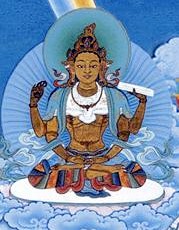Perfection of Wisdom Sutra in Eighteen Thousand Lines: Difference between revisions
No edit summary |
mNo edit summary |
||
| (3 intermediate revisions by 2 users not shown) | |||
| Line 1: | Line 1: | ||
[[Image:Prajnaparamita.jpg|frame|The goddess Prajñaparamita]] | [[Image:Prajnaparamita.jpg|frame|The goddess Prajñaparamita]] | ||
'''Perfection of Wisdom Sutra in Eighteen Thousand Lines''' (Skt. ''Aṣṭādaśasāhasrikā Prajñāpāramitā''; Tib. ཤེས་རབ་ཀྱི་ཕ་རོལ་ཏུ་ཕྱིན་པ་ཁྲི་བརྒྱད་སྟོང་པ་ (ཁྲི་བརྒྱད།), ''sherab kyi parol tu chinpa tri gye tongpa (tri gye)'', [[Wyl.]] ''shes rab kyi pha rol tu phyin pa khri brgyad stong pa (khri brgyad)'') is counted among the so-called [[six mother scriptures]], the most important [[prajnaparamita]] [[sutra]]s. | The '''Perfection of Wisdom Sutra in Eighteen Thousand Lines''' (Skt. ''Aṣṭādaśasāhasrikā Prajñāpāramitā''; Tib. ཤེས་རབ་ཀྱི་ཕ་རོལ་ཏུ་ཕྱིན་པ་ཁྲི་བརྒྱད་སྟོང་པ་ (ཁྲི་བརྒྱད།), ''sherab kyi parol tu chinpa tri gye tongpa (tri gye)'', [[Wyl.]] ''shes rab kyi pha rol tu phyin pa khri brgyad stong pa (khri brgyad)'') is counted among the so-called [[six mother scriptures]], the most important [[prajnaparamita]] [[sutra]]s. | ||
While setting forth the sacred fundamental doctrines of Buddhist practice with veneration, | While setting forth the sacred fundamental doctrines of Buddhist practice with veneration, this sutra simultaneously exhorts the reader to reject them as an object of attachment, its recurring message being that all [[dharma]]s without exception lack any intrinsic nature. | ||
The sutra can be divided loosely into three parts: an introductory section that sets the scene, a long central section, and three concluding chapters that consist of two important summaries of the long central section. <ref>84000 Translating the Words of the Buddha.</ref> | The sutra can be divided loosely into three parts: | ||
*an introductory section that sets the scene, | |||
*a long central section, and | |||
*three concluding chapters that consist of two important summaries of the long central section.<ref>84000 Translating the Words of the Buddha.</ref> | |||
==Text== | ==Text== | ||
The Tibetan translation of this text can be found in the Perfection of Wisdom section of the Tibetan [[Dergé Kangyur]], [[Toh]] 10. | The Tibetan translation of this text can be found in the Perfection of Wisdom section of the Tibetan [[Dergé Kangyur]], [[Toh]] 10. | ||
*English translation: | *English translation: {{84000|https://read.84000.co/translation/toh10.html|The Perfection of Wisdom in Eighteen Thousand Lines}} | ||
{{84000|https://read.84000.co/translation/toh10.html| The Perfection of Wisdom in Eighteen Thousand Lines}} | |||
==Further Reading== | ==Further Reading== | ||
| Line 16: | Line 18: | ||
*Edward Conze, ''The Prajñāpāramitā Literature'' (1960) | *Edward Conze, ''The Prajñāpāramitā Literature'' (1960) | ||
==Notes== | |||
<small><references/></small> | <small><references/></small> | ||
==Internal Links== | |||
*[[Perfection of Wisdom in Eight Thousand Lines]] | |||
*[[Perfection of Wisdom in Ten Thousand Lines]] | |||
*[[Perfection of Wisdom Sutra in Twenty-five Thousand Lines]] | |||
*[[Perfection of Wisdom Sutra in One Hundred Thousand Lines]] | |||
[[Category:Texts]] | [[Category:Texts]] | ||
Latest revision as of 10:49, 12 February 2024

The Perfection of Wisdom Sutra in Eighteen Thousand Lines (Skt. Aṣṭādaśasāhasrikā Prajñāpāramitā; Tib. ཤེས་རབ་ཀྱི་ཕ་རོལ་ཏུ་ཕྱིན་པ་ཁྲི་བརྒྱད་སྟོང་པ་ (ཁྲི་བརྒྱད།), sherab kyi parol tu chinpa tri gye tongpa (tri gye), Wyl. shes rab kyi pha rol tu phyin pa khri brgyad stong pa (khri brgyad)) is counted among the so-called six mother scriptures, the most important prajnaparamita sutras.
While setting forth the sacred fundamental doctrines of Buddhist practice with veneration, this sutra simultaneously exhorts the reader to reject them as an object of attachment, its recurring message being that all dharmas without exception lack any intrinsic nature.
The sutra can be divided loosely into three parts:
- an introductory section that sets the scene,
- a long central section, and
- three concluding chapters that consist of two important summaries of the long central section.[1]
Text
The Tibetan translation of this text can be found in the Perfection of Wisdom section of the Tibetan Dergé Kangyur, Toh 10.
- English translation:
 The Perfection of Wisdom in Eighteen Thousand Lines
The Perfection of Wisdom in Eighteen Thousand Lines
Further Reading
- Edward Conze, The Gilgit Manuscript of the Aṣṭādaśasāhasrikā Prajñāpāramitā
- Edward Conze, The Prajñāpāramitā Literature (1960)
Notes
- ↑ 84000 Translating the Words of the Buddha.